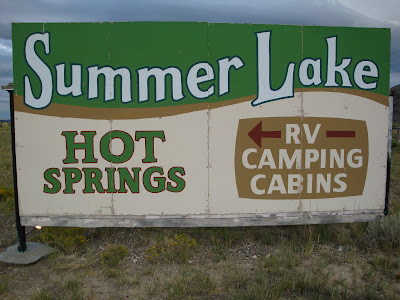
Most trips begin and end with a stop by Cougar (Terwilliger) Hot Springs. They are geothermal pools located in the Williamette National Forest, located about 53 miles east of Eugene. The springs drain into Rider Creek, which in turn drains into Cougar Reservoir They are located about a quarter mile in from Forest Service Road 19, also known as Aufderheide Memorial Drive. Visitors over the years built up four pools out of river stones. The pools' size ranged from three to twelve feet across and two to three feet deep, that cascade down a hillside. The source is above the topmost pool, where the spring flows out of a rock face at approximately 112 degrees Fahrenheit. Although the pool floors are mostly bedrock, some gravel, sand and debris are at the bottom if the pools haven't been cleaned recently.

Next stop was Crack in the Ground

Crack in the the Ground is a volcanic fissure over two miles long and up to 70 feet deep in central Oregon. The eruptions from the Four Craters Lava Field were accompanied by a slight sinking of the older rock surface. This shallow, graben-like sink is about 3 kilometers wide and extends to the south into an old lake basin. Crack-in-the-Ground marks the western edge of this small, volcano-tectonic depression. The crack is the result of a tension fracture along a hingeline produced by the draping of Green Mountain lava flows over the edge of upthrown side of the concealed fault zone.

Next stop was Summer Lake Hot Springs.

Summer Lake Hot Springs is found in one of the most unique, picturesque landscapes in the Pacific Northwest, Lake County, Oregon, which is among the few truly unspoiled places on earth. Part of the Great Basin region of the United States, Lake County is home to numerous large alkali lakes. At the south end of one of these, Summer Lake, lies ancient artesian hot mineral springs.

The timber frame and corrugated metal structure was built in 1928 surrounding the large hot mineral pool, providing year round comfort for soaking and healing. The 106 - 113 degree spring fills the pool through a 4-inch pipe, which many find therapeutic to stand underneath, allowing the hot mineral water to fall upon necks and shoulders, melting away tension for a deep therapeutic healing.

The Outback Tour continues on to Hart Mountain Hot Springs.

Hart Mountain (s/k/a Antelope) are natural hot springs located in southeastern Oregon, northeast of the community of Plush. The springs emerge at 104 °F in a semi-improved, accessible location suitable for camping within the Hart Mountain National Antelope Refuge. The pool is about 5 feet deep and 9 by 12 across. The pool can accommodate six people. Reportedly a rancher noticed some water bubbling from a rock and blasted it with dynamite resulting in a hot spring pool.

Well soaked, I'm off to the Steens Mountain, which is a large fault-block mountain in the southeastern part of Oregon. Located in Harney County, it stretches some 50 miles (80 km) and rises from an elevation of about 4,200 feet above the Alvord Desert to its peak at 9,733 feet. It is sometimes confused with a mountain range, but is properly a single mountian. The east face of the Steens Mountain is almost entirely comprised of basalts stacked one upon another. Staggering amounts of magma, with several flows hundreds of feet deep, inundated the region.

The Alvord Desert from the top of the Steens Mountain.

Now on to Fields and Borax Hot Springs. Borax Lake and the nearby string of hot springs are one of the most unusual geothermal areas in Oregon This spring is not suitable for soaking as it is about 160 degrees but is a Yellowstone quality hot spring.

A string of more than a dozen hot springs that march north along a fault line in the Oregon desert. The thermal water from the southernmost hot springs creates a five-acre warm-water lake. The hot pools march single file along an imaginary line that follows a geologic fault beneath the desert’s surface.

Borax Lake has superheated, 196-degree F water that gushes up through vents in the bottom of Middle Borax Lake, cooling as it disperses, to a temperature in the mid-80s that varies in different parts of the lake and times of year. It’s a modest lake, only about 300 feet across, and only a foot or so deep until you’re well out from shore. The center is quite deep and very pleasant swimming on a warm day.

Now it was on to Three Forks Hot Springs.

Without a doubt, Three Forks in southeastern Oregon is one of the finest hot spring I have ever visited.

It is not close to anywhere, so it isn't a trip to take on a whim. Three forks of the Owyhee River flow together about 40 miles south of the nearest pavement. Even without the presence of the hot springs, this area is worth a trip. It's simply beautiful!

I was there in August--a good time, since the river was low and it's necessary to ford the river to get to the best springs.

Next, it was on to Whitehorse Hot Springs.

Whitehorse or Willow Creek Hot Springs is a muddy bottomed, 4 ft deep pool that's about 9 feet wide. There are some natural rock steps and concrete/rock divider that creates two pool with slightly different temperatures.

Use of Alvord Hot Springs is free and open to the public year round, though they are on private property. Maintenance is volunteered by local residents and all visitors are encouraged to help keep the springs clean.

Those are washing machine tubs, which are used to sit on to enjoy the waters.

Crossing back over the Cascades at McKenzie Pass, gives one a view of the Sisters and the lave field.


No comments:
Post a Comment